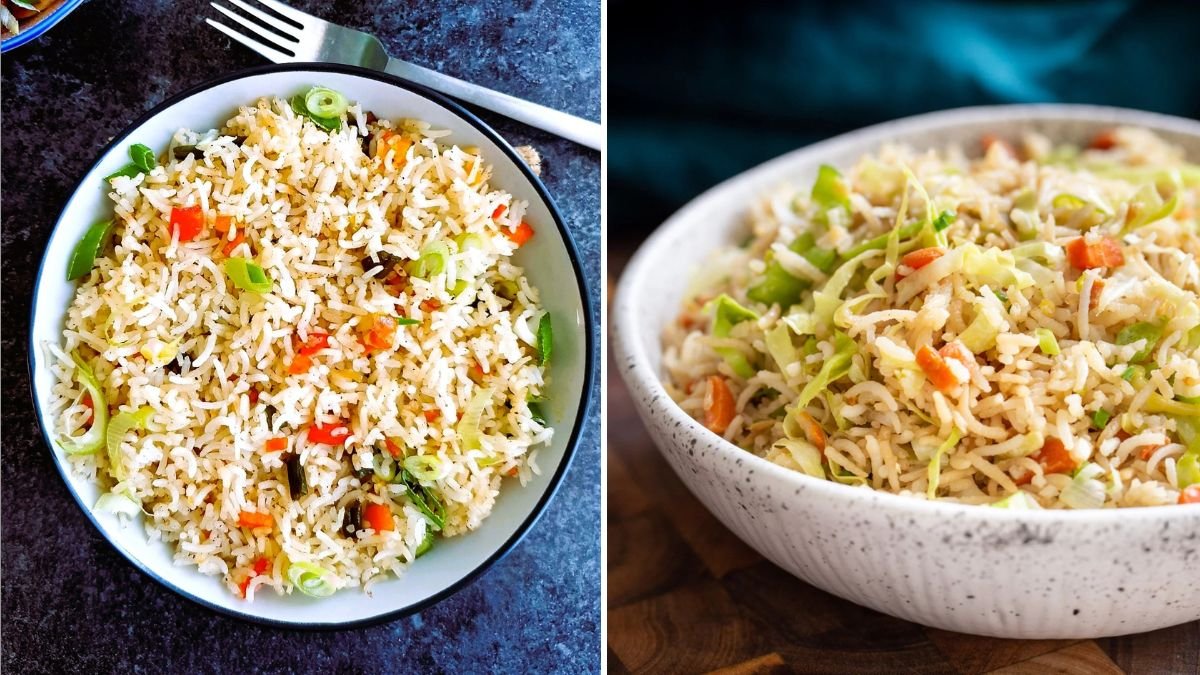Vegetable Fried Rice Indo-Chinese Style is a vibrant, flavorful dish loved for its perfect blend of Chinese stir-frying techniques and Indian flavors. This dish is not only colorful and aromatic but also quick, versatile, and satisfying. Packed with crisp vegetables, soy sauce, and aromatic spices, it’s a perfect accompaniment to Indo-Chinese main courses or a standalone meal.
This guide provides a 6-step process to prepare Vegetable Fried Rice Indo-Chinese Style, covering ingredient selection, cooking techniques, seasoning, and serving tips to help you make restaurant-style fried rice at home.
Step 1: Gather Fresh Ingredients
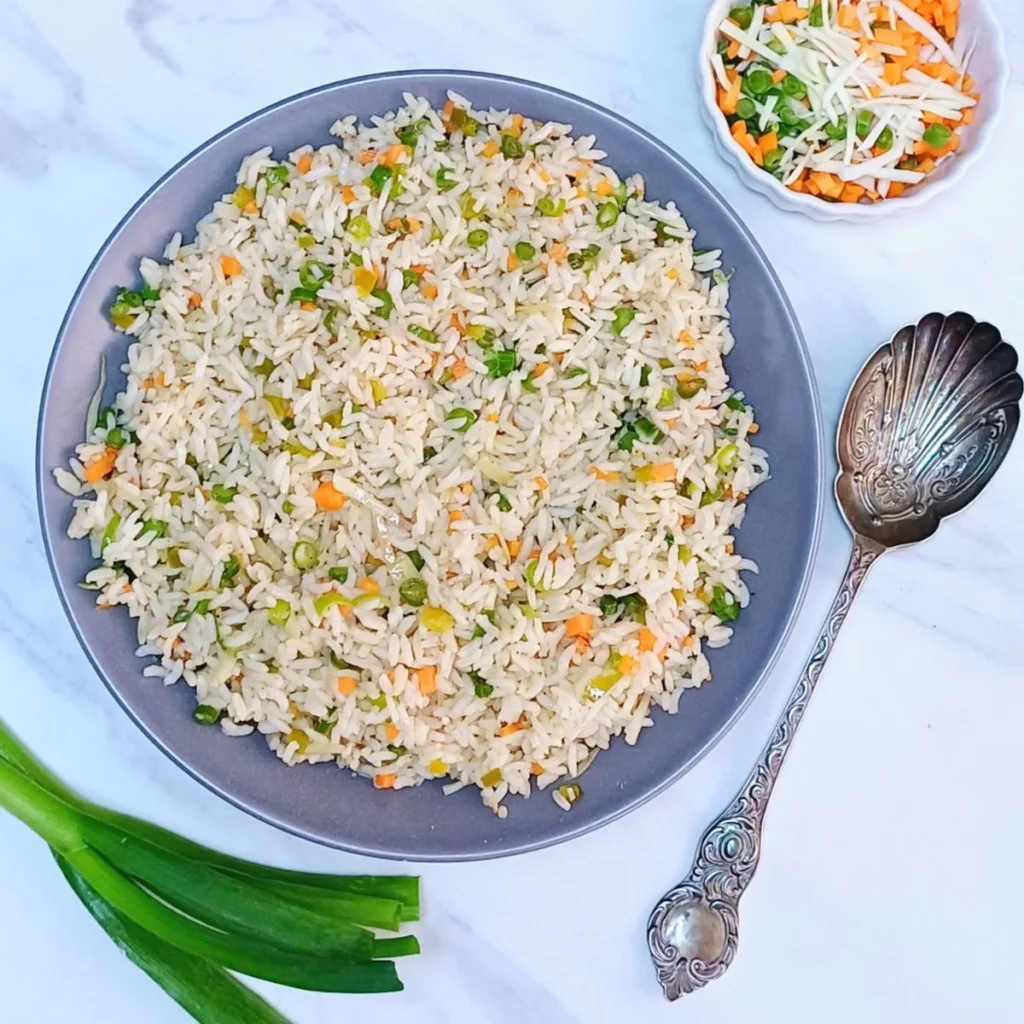
The secret to perfect fried rice lies in using fresh vegetables, cooked rice, and high-quality sauces.
Ingredients:
For the Rice:
- Long-grain Basmati Rice: 1 cup (cooked and cooled)
- Water: For boiling
- Salt: To taste
For Vegetables:
- Carrots: ½ cup, diced
- Capsicum/Bell Peppers: ½ cup, diced
- Green Beans: ½ cup, chopped
- Cabbage: ½ cup, finely shredded
- Spring Onions: 2–3, chopped (white for cooking, green for garnish)
- Garlic: 2–3 cloves, finely chopped
- Ginger: 1 teaspoon, finely chopped
For Seasoning & Sauce:
- Soy Sauce: 1–2 tablespoons
- Chili Sauce (optional): 1 teaspoon
- Vinegar: ½ teaspoon
- Black Pepper Powder: ½ teaspoon
- Oil: 2 tablespoons (vegetable or sesame)
- Salt: To taste
Optional Toppings:
- Fried Shallots
- Toasted sesame seeds
Tip: Using day-old cooked rice or freshly cooked rice cooled completely prevents sticky rice, ensuring perfect fried rice texture.
Step 2: Cook and Prepare Rice
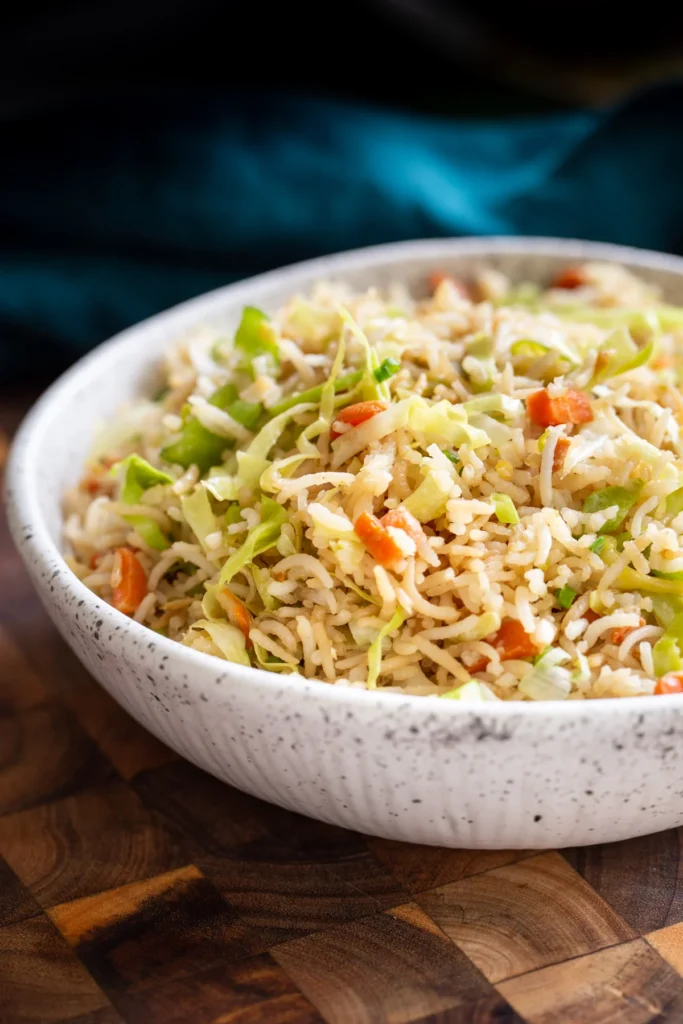
Proper rice preparation ensures separate, fluffy grains that don’t stick during stir-frying.
Instructions:
- Wash 1 cup basmati rice thoroughly under running water to remove excess starch.
- Cook in 2 cups water with a pinch of salt until soft but not mushy.
- Drain excess water, if any, and let the rice cool completely.
- Spread rice on a plate or tray to avoid clumping.
Tip: Using cooled or day-old rice ensures grains remain separate and absorb flavors effectively while stir-frying.
Step 3: Prepare Vegetables
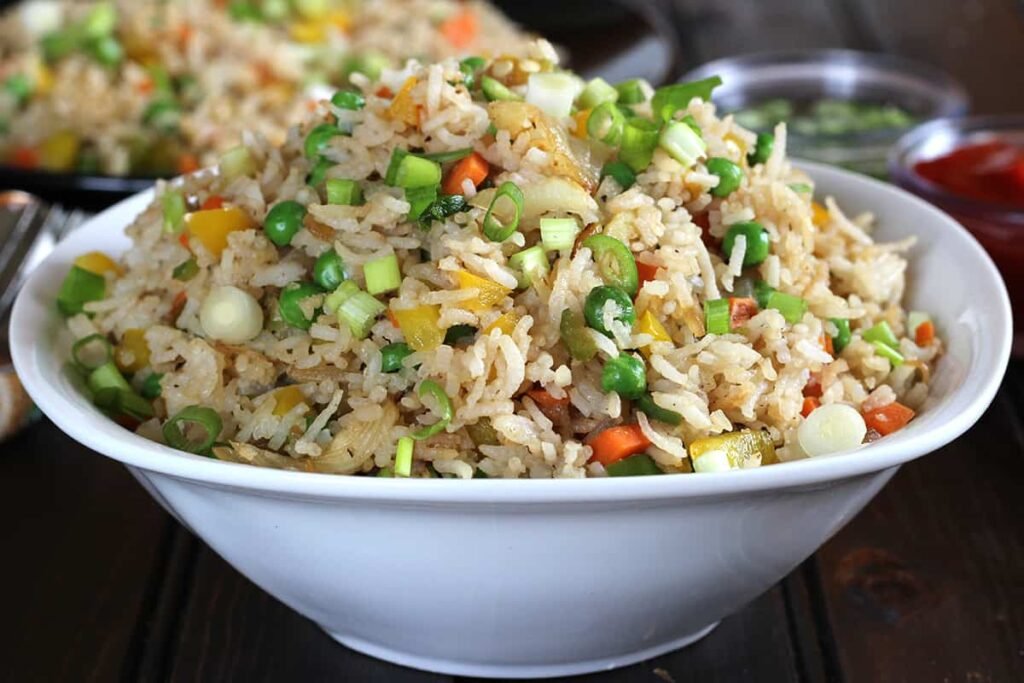
Vegetables should be uniformly cut to ensure even cooking and a crunchy texture.
Instructions:
- Wash and peel vegetables as needed.
- Dice carrots, capsicum, and beans into small, uniform pieces.
- Shred cabbage finely.
- Chop garlic, ginger, and the white part of spring onions for cooking.
- Keep green spring onion tops aside for garnishing.
Tip: Cut vegetables uniformly so they cook evenly and retain crunchiness without overcooking.
Step 4: Stir-Fry Vegetables
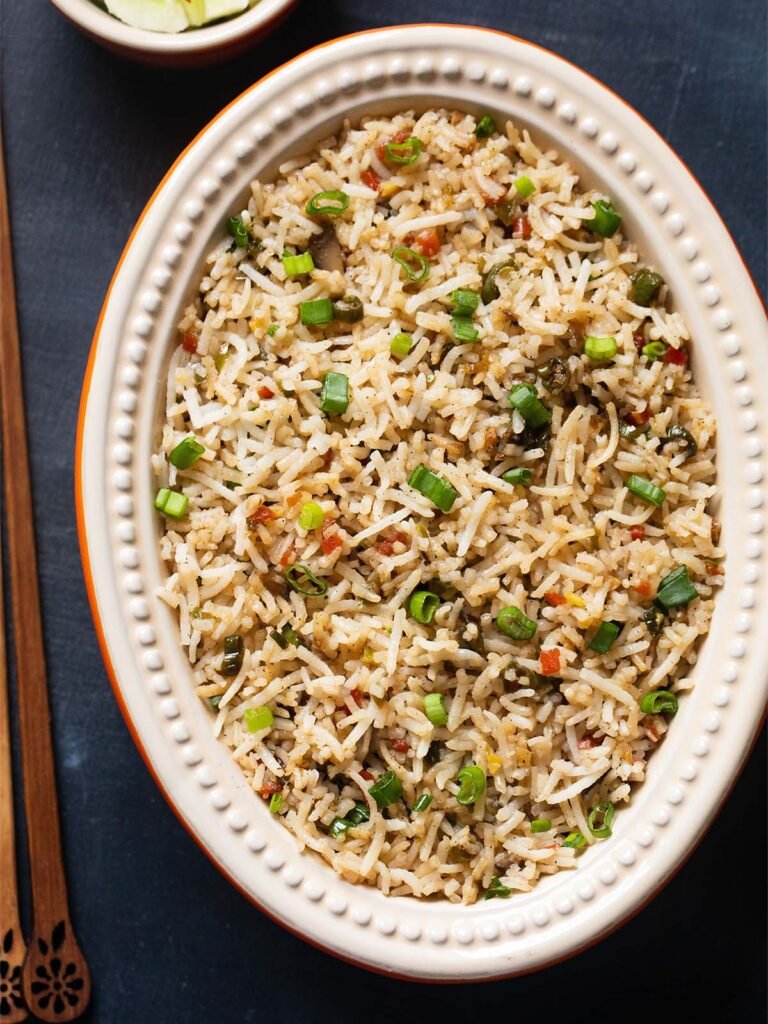
Stir-frying vegetables on high heat keeps them crisp, colorful, and flavorful.
Instructions:
- Heat 2 tablespoons oil in a wok or large skillet over high heat.
- Add chopped garlic, ginger, and white parts of spring onions; sauté for 30–40 seconds until aromatic.
- Add diced carrots, beans, and bell peppers; stir-fry for 2–3 minutes.
- Add shredded cabbage; continue stir-frying for 1–2 minutes.
- Season with a pinch of salt and black pepper.
Tip: Quick, high-heat stir-frying ensures vegetables remain crisp and maintain vibrant colors, a hallmark of restaurant-style fried rice.
Step 5: Combine Rice and Sauces
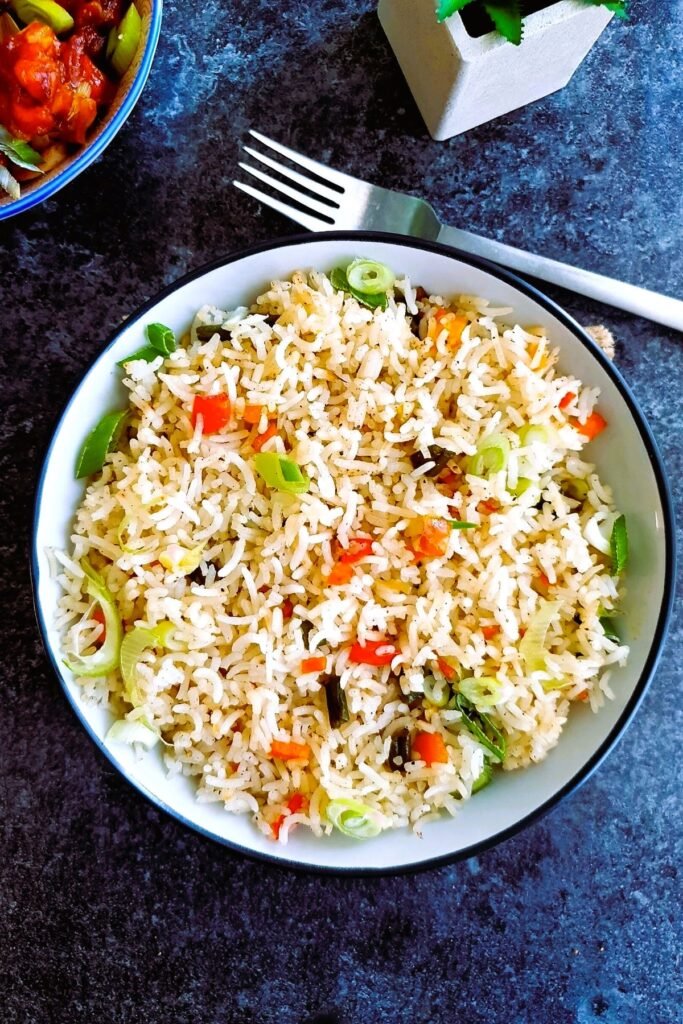
Combining rice and sauces correctly ensures even flavor distribution without mushiness.
Instructions:
- Reduce heat to medium-high and add cooled rice to the stir-fried vegetables.
- Gently toss to mix rice with vegetables without breaking grains.
- Add soy sauce, chili sauce, and vinegar evenly over the rice.
- Stir-fry for 3–4 minutes to allow flavors to blend thoroughly.
- Taste and adjust salt, pepper, or sauce as needed.
Tip: Keep tossing gently to prevent rice from sticking and maintain a perfect separate-grain texture.
Step 6: Garnish and Serve
Finishing touches enhance presentation, aroma, and flavor.
Instructions:
- Turn off heat and garnish with green spring onion tops.
- Optionally, sprinkle fried shallots or toasted sesame seeds for crunch and aroma.
- Serve hot as:
- Main dish with Manchurian, Chilli Paneer, or Gobi 65
- Side dish for Indo-Chinese thalis
- A quick weeknight meal with minimal prep
Tip: Serve immediately to retain the crunchiness of vegetables and aromatic flavors.
Extra Tips for Perfect Indo-Chinese Vegetable Fried Rice
- Rice Choice: Long-grain basmati rice works best; avoid sticky rice.
- High Heat Cooking: Stir-frying on high heat ensures crisp vegetables and smoky flavors.
- Sauce Balance: Adjust soy sauce, chili sauce, and vinegar according to taste; Indo-Chinese dishes are slightly tangy and savory.
- Vegetable Crunch: Add vegetables in stages; harder vegetables first, softer ones later.
- Avoid Overcrowding Wok: Stir-fry in batches if needed to prevent steaming instead of frying.
Common Mistakes to Avoid
- Using Freshly Cooked Hot Rice: Leads to sticky fried rice; always cool rice completely.
- Overcooking Vegetables: Results in soft, soggy texture; aim for slight crunch.
- Too Much Sauce: Over-saucing makes fried rice wet and mushy.
- Under-seasoning: Indo-Chinese flavor comes from soy sauce, vinegar, and balanced spices.
- Stirring Aggressively: Breaks rice grains; gentle tossing preserves texture.
Healthier Variations
- Use less oil or substitute with olive oil for a healthier version.
- Add extra vegetables like baby corn, mushrooms, or zucchini for fiber and nutrition.
- Use low-sodium soy sauce to reduce sodium content.
- Pair with brown rice instead of white rice for a whole-grain option.
Tip: Even with healthier swaps, the bold Indo-Chinese flavors remain intact with proper seasoning.
Serving Suggestions
- Serve with Manchurian gravy, Chilli Paneer, or Gobi 65 for a complete Indo-Chinese meal.
- Pair with spring rolls or crispy momos for appetizers.
- Serve as a quick weekday lunch for families or as a party dish for gatherings.
- Garnish with lime wedges to add a fresh tangy flavor.
Tip: Indo-Chinese Vegetable Fried Rice is versatile and can adapt to different protein additions like tofu, paneer, or boiled eggs.
Final Thoughts
Making Vegetable Fried Rice Indo-Chinese Style at home is easy, quick, and satisfying when you follow these 6 steps—cooking rice, preparing vegetables, stir-frying, adding sauces, tossing properly, and garnishing.
This dish combines nutritious vegetables, aromatic sauces, and perfectly cooked rice, making it a colorful, flavorful, and wholesome meal. By paying attention to rice texture, vegetable crunch, and sauce balance, you can enjoy restaurant-quality fried rice at home anytime.
Whether served as a main meal, side dish, or party platter, Indo-Chinese Vegetable Fried Rice is a crowd-pleaser that brings the flavors of your favorite Chinese restaurant straight into your kitchen.
